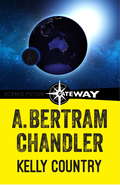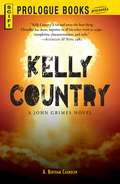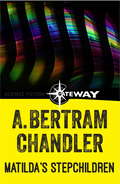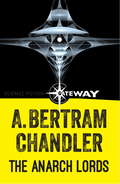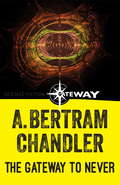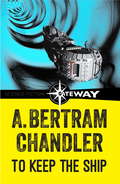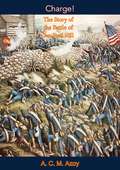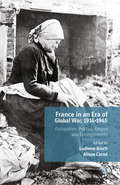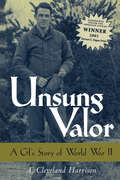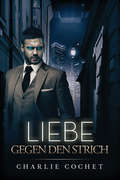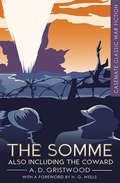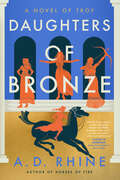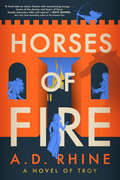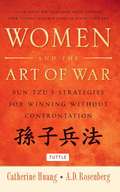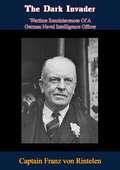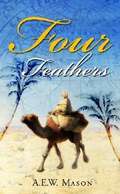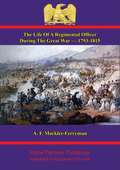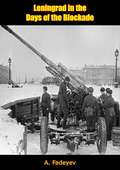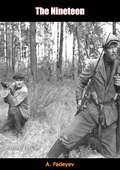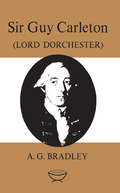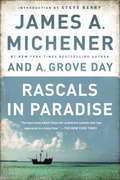- Table View
- List View
Kelly Country
by A. Bertram ChandlerThere was a Ned Kelly. He lived and breathed and fought for what he believed to be right - according to the historians. According to others he was no more than a bushranger, a vicious criminal who paid the just penalty for his crimes on the gallows. But what if he had lived. What would have been the consequences for Australia - and the world?
Kelly Country
by A. Bertram ChandlerThere was a Ned Kelly. He lived and breathed and fought for what he believed to be right - according to the historians. According to others he was no more than a bushranger, a vicious criminal who paid the just penalty for his crimes on the gallows. But what if he had lived. What would have been the consequences for Australia - and the world?
Kelly Country: A John Grimes Novel
by A. Bertram ChandlerAn If-Of-History NovelThe United States won its independence in 1776, and the world has never been the same since. What if Australia had followed suit? How would our world have been different? That’s the theme that fascinated A. Bertram Chandler who saw, in the famous Ned Kelly, the possibility of an Australian Washington.For Ned Kelly was not just a lawless bushranger. He was a man of unusual imagination who created his own armor, gathered a band of Irish rebels, and took arms against the frontier law of old Australia. Now, by time machine and calculated interference, a certain 20th Century John Grimes goes back and alters history. Kelly survives!Utilizing the hidden discoveries of science, Kelly helps an Austrailian-Irish Republic rise from Down Under!
Matilda's Stepchildren (John Grimes)
by A. Bertram ChandlerJohn Grimes, owner of the deep space pinnace Little Sister, could not be too fussy about who he carried. Fenalla Pruin, the muckraking reporter, was always going to be trouble. They need the boomerang throwing abilities of two sexy dancers from New Alice to get them out of trouble.
The Anarch Lords (John Grimes)
by A. Bertram ChandlerHis wild career as a space pirate ended, Grimes faced his toughest assignment - he was "punished" by being made governor of the anarchists' own planet! John Grimes, living legend of the spaceways, had been in and out of some cosmic catastrophes but this threatened to reach his luck's ultimate breaking point!An influx of planetary refugees had made that world a paradise of cheap labor and the original anarchist colonists had become such masters of wealth that no mere outsider could hope to dictate "law and order" to them. They had their own ideas which included slavery, treachery, and utter villainy.Grimes' first task as governor would be simply to stay alive with a whole world plotting his murder!
The Gateway to Never (John Grimes)
by A. Bertram ChandlerJohn Grimes is stranded on a Hell Planet! Another adventure with the pipe-smoking, action-loving spaceship commander Lieutenant John Grimes.
To Keep The Ship
by A. Bertram ChandlerJohn Grimes falls into the clutches of terrorists. Its going to talk all his efforts to keep his precious golden ship. (Especially as it is infected with mini-Susies who were sharp-toothed, hungry and ready to eat him alive.)
To Keep The Ship (John Grimes)
by A. Bertram ChandlerJohn Grimes falls into the clutches of terrorists. Its going to talk all his efforts to keep his precious golden ship. (Especially as it is infected with mini-Susies who were sharp-toothed, hungry and ready to eat him alive.)
Star Trek: Sand and Stars (Star Trek: The Original Series)
by A. C. Crispin Diane DuaneVulcan: linchpin member of the United Federation of Planets. Home to a civilization dedicated to o'thia, the ruling ethic of pure logic. But it was not always so; thousands of years before, Vulcans were a violent, warlike race, with tempers surpassed only by the planet's hot, arid sands. The philosopher Surak would show his people another way, teach them to reject their emotions and embrace logic and knowledge. The Vulcans would evolve and prosper, eventually exploring the stars and attaining further enlightenment as they encountered other cultures. In the twenty-third century, Commander Spock, Captain Kirk, and the U.S.S. Enterprise are summoned to Vulcan when its people consider seceding from the Federation and returning to their isolationist ways. Vulcan's savage history becomes fully revealed as Spock, his father Sarek, and Kirk work to preserve the planet's future from anti-Terran factions with hidden agendas. The crisis is twofold for the half-human Spock -- should Vulcan secede, he will be required to resign from Starfleet and return home, or forever sever ties with his homeworld. Years later, a decades-old plot to destroy the Federation from within forces Ambassador Sarek from the bedside of his dying wife, Amanda. The ambassador's decision widens the long-standing rift between himself and Spock at a time when they must pool their resources together. While the Enterprise crew contends with Romulans, Klingons, and the mysterious Freelans, Sarek's only comfort comes from reading Amanda's journals, which reveal more about his human spouse, his son, and himself than he ever realized.
Charge! The Story of the Battle of San Juan Hill: The Story Of The Battle Of San Juan Hill (classic Reprint)
by A. C. M. AzoyThe Battle of San Juan Hill of July 1, 1898, also known as the battle for the San Juan Heights, was a decisive battle of the Spanish-American War. The San Juan heights was a north-south running elevation about 2 kilometres (1.2 miles) east of Santiago de Cuba, Cuba. This fight for the heights was the bloodiest and most famous battle of the war. It was also the location of the so called “greatest victory” for the Rough Riders, as stated by the press and its new commander, Theodore Roosevelt, who eventually became vice president and later president of the United States, and who was posthumously awarded the Medal of Honor in 2001 for his actions in Cuba.In Charge! The Story of the Battle of San Juan Hill, Colonel Azoy reconstructs the events of the Battle of San Juan Hill, the climax of the Spanish-American War, a war that so strongly shaped the course of American Development and one that has until now been curiously ignored in the annals of American historical writing.
France in an Era of Global War, 1914-1945: Occupation, Politics, Empire and Entanglements
by A. Carrol L. BrochIn France in an Era of Global War, scholars re-examine experiences of French politics, occupation, empire and entanglements with the Anglophone world between 1914 and 1945. In doing so, they question the long-standing myths and assumptions which continue to surround this period, and offer new avenues of enquiry.
Unsung Valor: A GI's Story of World War II
by A. Cleveland HarrisonWinner of the 2001 Forrest C. Pogue Prize from the Eisenhower Center for American StudiesWhen drafted into the army in 1943, A. Cleveland Harrison was a reluctant eighteen-year-old Arkansas student sure that he would not make a good soldier. But inside thirty months he manfully bore arms and more. This book is his memoir about becoming a soldier, a common infantryman among the ranks of those who truly won the war. After the Allied victory in 1945, books by and about the major statesmen, generals, and heroes of World War II appeared regularly. Yet millions of American soldiers who helped achieve and secure victory slipped silently into civilian life, trying to forget the war and what they had done. Most remain unsung, for virtually none thought of themselves as exceptional. During the war ordinary soldiers had only done what they believed their country expected. Harrison's firsthand account is the full history of what happened to him in three units from 1943 to 1946, disclosing the sensibilities, the conflicting emotions, and the humor that coalesced within the naive draftee. He details the induction and basic training procedures, his student experiences in Army pre-engineering school, his infantry training and overseas combat, battle wounds and the complete medical pipeline of hospitalization and recovery, the waits in replacement depots, life in the Army of Occupation, and his discharge. Wrenched from college and denied the Army Specialized Training Program's promise of individual choice in assignment, students were thrust into the infantry. Harrison's memoir describes training in the Ninety-fourth Infantry Division in the U.S., their first combat holding action at Lorient, France, and the division's race to join Patton's Third Army, where Harrison's company was decimated, and he was wounded while attacking the Siegfried Line. Reassigned to the U.S. Group Control Council, he had a unique opportunity to observe both the highest echelons in military government and the ordinary soldiers as Allied troops occupied Berlin. This veteran's memoir reveals all aspects of military life and sings of those valorous but ordinary soldiers who achieved the victory.
Liebe gegen den Strich
by Charlie Cochet A. D. FerenczKelly Sutton ist ein ehrgeiziger junger Amerikaner, der als Praktikant bei der Photonic Royal Society in New London arbeitet. Seit über einem Jahr ist er dem Projekt Mars zugeteilt, das so geheim ist, dass selbst Kelly nicht weiß, worum es sich dabei genau handelt. Er weiß nur, dass seine Mitarbeit an dem Projekt zum Wohl der Menschheit ist. Und mehr interessiert ihn auch nicht. Kellys Welt wird auf den Kopf gestellt, als ihn die Sorge um das merkwürdige Verhalten seines Mentors zufällig über ein streng gehütetes, fürchterliches Geheimnis stolpern lässt. Hinter dem Projekt, das offiziell der Verbesserung des menschlichen Lebens dienen soll, verbirgt sich das Potential zu Gewalt und Vernichtung. Diese schreckliche Erkenntnis zwingt Kelly zu einer Entscheidung. Soll er die Augen vor der Wahrheit verschließen und seinen Job behalten, wie er es immer getan hat, oder soll er seine Karriere riskieren und den Mann retten, der ihm das Herz geraubt hat?
The Somme: Also Including The Coward (Casemate Classic War Fiction #3)
by A. D. GristwoodTwo World War I classics: The story of a British soldier enduring the battle in France and a novella starring a man who takes drastic steps to escape the Great War.The million British dead have left no books behind. What they felt as they died hour by hour in the mud, or were choked horribly with gas, or relinquished their reluctant lives on stretchers, no witness tells. But here is a book that almost tells it. . . . Mr. Gristwood has had the relentless simplicity to recall things as they were; he was as nearly dead as he could be without dying, and he has smelt the stench of his own corruption. This is the story of millions of men—of millions.&” —H. G. Wells In The Somme and its companion The Coward, first published in 1927, the heroics of war and noble self-sacrifice are completely absent, replaced by the gritty realism of life for the ordinary soldier in World War I and an unflinching portrayal of the horrors of war. Written under the guidance of master storyteller H. G. Wells, they are classics of the genre. Based on A. D. Gristwood&’s own wartime experiences, The Somme revolves around a futile attack during the 1916 Somme campaign. On the battlefront, Tom Everitt is wounded and must be moved back through a series of dressing stations to the General Hospital at Rouen. Few other accounts of the war give such an accurate picture of trench life, and The Spectator praised Gristwood&’s &“very effective writing,&” calling The Somme &“a book which anyone who was not in the War should read.&”The Coward concerns a man who shoots himself in the hand to escape the chaos during the March 1918 retreat—an offense punishable by death—and is haunted by fear of discovery and self-loathing. Together, these works offer a vivid, immersive view of the First World War and the suffering it inflicted on the men who fought it.
Daughters of Bronze: A Novel of Troy
by A. D. RhineSong of great sorrow. Even greater love. Lost between the timeless lines of Homer&’s epic, the women of Troy finally stand to be counted. Their story is one you&’ve never encountered, and it will change the fate of Troy forever. Andromache has proven herself a capable leader, but can she maintain that hard-won status now that she is the mother to the city&’s long-awaited heir? With enemies closing in, Andromache must bring together a divided city in time to make a final stand. Rhea is a Trojan spy, but she never expected to find love in the enemy camp. When the final battle lines are drawn, Rhea must decide where her loyalties lie and how much she is willing to lose. Helen is no longer the same broken woman first brought to Troy as a captive. Given a second chance at life, she must cast off her shroud of grief and use her healing gifts to save Troy&’s greatest hope. Cassandra has seen Troy&’s fate. But she knows the truth is only as valuable as the person who tells it . . . and few in Troy value her. All that is about to change. One hero will rise, another will fall . . . and this time, Cassandra will have her say. From the highest tower to the most humble alley, the bloody beaches to the dusty plain, Daughters of Bronze is the thrilling conclusion to the duology that began with Horses of Fire, and breathes life into the Troy of myth and history. It is an epic of a thousand invisible actions leading to a single moment, adding a refrain of unexpected light to the legend of Troy.
Horses of Fire: A Novel of Troy
by A. D. Rhine&“One of those singular books that pulls readers into a completely immersive world with a dazzling story and characters so deftly drawn that you can&’t help but ache for them.&”–New York Times bestselling author Lisa MaxwellI know the stories they will tell. I&’ve heard the echoes of their songs—songs that will outlive us all. But this song is not theirs. It is mine. Behind the timeless tale you know is the captivating story you never heard: a sweeping epic in which Troy&’s strong, yet misunderstood women take center stage in the most famous war in history. Andromache is cast as the doting wife of Prince Hector, yet her Amazon warrior name means &“battler of men.&” The only one with the cunning to outwit the invading Greeks, she must gather a band of outcasts and become the military commander she was born to be before the life she and Hector have built is reduced to ashes. Rhea is a war refugee and a horse whisperer who finally earns a place and sense of belonging in Hector&’s stables. To save her new home, she must become an unlikely spy and face down a forbidden love that will test all her loyalties. Helen is blamed by all for starting the Trojan War, but no one knows her real story. To escape her tormentor and foil a plot to undermine Hector, Helen must risk everything by revealing her true face to the one who despises her most. Set in the wider landscape of the late Bronze Age collapse, this realistic and immersive Troy is a perilous battleground for warriors and politicians alike, not a playground where the fate of men and women make sport for gods and goddesses. The first book in an epic duology, Horses of Fire is a harrowing novel of palace intrigue, the transcendent bond of female friendship, and the everyday bravery of invisible heroes in times of war. The women of Troy are threads spinning on a single loom. Can they reweave the tapestry of fate?
Women and the Art of War
by A. D. Rosenberg Catherine HuangWomen and The Art of War helps women find the peaceful path to success through strategies made famous in the ancient Chinese text, The Art of War. Female wisdom, or common sense, is about avoiding needless confrontation, conserving energy for the things that matter, and seeking an outcome in which everyone wins. And for women, as for Sun Tzu, success doesn't come simply from knowing what to do, but from knowing who you are.Women and the Art of War will help you discover how to use your natural abilities to find your path. It will help you consider what you want to achieve and why you want to achieve it. Covering Sun Tzu's timeless principles point by point in a conversational and friendly tone, Women and the Art of War shows you how you can find your strengths, meet your weaknesses head-on, deal with obstacles and forge your own unique identity through your career and personal life. Whatever your path, this book will give you strategies, tactics, and practical examples you need to increase your probability of success--and enjoy the process.
Women and the Art of War
by A. D. Rosenberg Catherine HuangWomen and The Art of War helps women find the peaceful path to success through strategies made famous in the ancient Chinese text, The Art of War. Female wisdom, or common sense, is about avoiding needless confrontation, conserving energy for the things that matter, and seeking an outcome in which everyone wins. And for women, as for Sun Tzu, success doesn't come simply from knowing what to do, but from knowing who you are.Women and the Art of War will help you discover how to use your natural abilities to find your path. It will help you consider what you want to achieve and why you want to achieve it. Covering Sun Tzu's timeless principles point by point in a conversational and friendly tone, Women and the Art of War shows you how you can find your strengths, meet your weaknesses head-on, deal with obstacles and forge your own unique identity through your career and personal life. Whatever your path, this book will give you strategies, tactics, and practical examples you need to increase your probability of success--and enjoy the process.
The Dark Invader: Wartime Reminiscences Of A German Naval Intelligence Officer
by A. E. W. Mason Captain Franz von RintelenMen engaged in Intelligence Services during a war divide their particular opponents into two classes. One consists of neutrals who go out of their way to help the enemy for the sake of gain; and for such men we have not much compassion should they fall upon misfortune. They are interfering in great matters with which they are not concerned, in order to make a little money. The other class is made up of men who, abandoning the opportunities of their own careers, go secretly away in the sacred service of their country, play a lone hand, and run the gauntlet of foreign laws. For such we can have nothing but respect while the fight is going on and friendship when it is over.Captain Franz von Rintelen belongs to this latter class. A young naval officer with every likelihood of reaching to high rank, he went abroad in 1915 and only saw his own country again after the lapse of six strenuous and, in part, unhappy years. The history of those years is told in this book. The conversations which he records depend, of course, upon his memory; the main facts we are able to check, and we know them to be exact.The book is written, as one would expect from his record, without the least rancour, and I think I am not trenching upon the province of criticism when I add--with admirable simplicity. It is a record which is more detailed and concerned with endeavours on a vastly wider scale than is usual in such accounts. One cannot, I think, read it without recognising, apart from the magnitude of the things attempted and done, the terrific strain under which he lived; and this gives a moving and human quality to the narrative which sets it a little apart from any other which I have read. Those who are most saturated in spy stories will find much to surprise them in this volume, and they will not be likely to forget the poignant minutes which he spent on the top of an omnibus in London and the way in which those minutes ended.Finally, here is as good an argument against War as a man could find in twenty volumes devoted to that subject alone.
The Four Feathers
by A. E. W. MasonThis classic adventure story -- first published in1902 -- gains new life in a blockbuster motion picture epicfrom Paramount Pictures and Miramax Films and remainsa timeless novel of love, honor, and courage. A Soldier's Shame. . . It is 1882 and British officer Harry Feversham has it all: a loving fiancée, the camaraderie of fellow soldiers, a bright future in a nation at the height of its imperial power. But before he is deployed to battle in Africa, he resigns -- and receives white feathers, symbols of cowardice, from three friends. . . and then a fourth from his fiancée. A Love Lost. . . Ethne Eustace has pushed Harry out of her life, but not out of her mind. Still, when another suitor comes calling she makes a decision that could destroy Harry. . . and alter her life forever. A Heroic Redemption. . . His world in tatters, Harry goes undercover in Africa to win back the respect of his comrades. From the bustling markets of Cairo to the sizzling sands of Omdurman prison, he fights with everything he has to bring honor back to his name. . . and Ethne back to his heart.
The Life Of A Regimental Officer During The Great War — 1793-1815: Compiled From The Correspondence Of Colonel Samuel Rice, C.B., K.H. 51st Light Infantry And From Other Sources
by A. F. Mockler-Ferryman Colonel Samuel Rice C.B., K.H.The 51st Light Infantry, or 52nd as they were numbered during the French wars, were always viewed as a crack unit within the Duke of Wellington's Peninsular army. As a part of the Light Division, they formed part of the skirmish screen that would be the first to strike during an advance and the last bulwark of defence during a retreat.Colonel Samuel Rice fought in all of the 51st campaigns during the period starting as the most junior of officers, an ensign rising to the rank of Lt.-Colonel in November 1813. He fought in the engagements at Coruña, Fuentes d'Oñoro, Cuidad Rodrigo, the storm of Badajoz, Salamanca, San Murcial and Orthez. He also saw service on Corsica, Cape of Good Hope, Sri Lanka and at Waterloo near Hougomont. His letters are blended into a tight and gripping narrative by Antony Mockler-Ferryman, blending a historical overview with the eye-witness details of the individual.Author -- Mockler-Ferryman, A. F. 1856-1930.Author -- Colonel Samuel Rice, C.B., K.H.Text taken, whole and complete, from the edition published in Edinburgh, W. Blackwood and sons, 1913. Original Page Count - xv, 326 pages.
Leningrad in the Days of the Blockade
by R. D. Charques A. FadeyevThe 900 day siege of Leningrad (now St. Petersburg) on the Baltic was perhaps one of the most iconic clashes of Nazi versus Soviet clashes to take place during the Second World War. Two and a half million Russians were trapped and encircled by Germand and Finnish forces, but despite freezing cold, scant supplies and little if any food, the city held out. In this book, noted Soviet author Alexander Alexandrovitch Fadeyev gives an eyewitness account of the horrific conditions of the city in the iron jaws of the Wehrmacht.
The Nineteen
by R. D. Charques A. FadeyevRazgrom (literally: devastation, debacle), here translated under the title of The Nineteen, was Russian author Alexander Fadeyev’s third novel. It has been widely acclaimed in Russia as one of the best novels of that decade and a significant artistic embodiment of revolutionary faith in a new Russia. A story of youthful guerrilla fighters it still stands as a fine work of modern Russian literature.
Sir Guy Carleton: Lord Dorchester
by A. G. BradleyThis biography of Sir Guy Carleton was first published in the famous Makers of Canada series in 1907, and re-issued in 1926 with supplementary notes incorporating later research by A.L. Burt. When it first appeared it was reviewed by William Wood, who described it as "a really good book on one of the greatest makers of the Empire."
Rascals in Paradise: Turbulent Adventures and Bold Courage on the South Seas
by James A. Michener A. Grove DayIn a thrilling collection of nonfiction adventure stories, James A. Michener returns to the most dazzling place on Earth: the islands that inspired Tales of the South Pacific. Co-written with A. Grove Day, Rascals in Paradise offers portraits of ten scandalous men and women, some infamous and some overlooked, including Sam Costock, a mutinous sailor whose delusions of grandeur became a nightmare; Will Mariner, a golden-haired youth who used his charm to win over his captors; and Captain Bligh, the notorious HMS Bounty captain who may not have been the monster history remembers him as. From lifelong buccaneers to lapsed noblemen, in Michener and Day's capable hands these rogues become the stuff of legend. BONUS: This edition includes an excerpt from James A. Michener's Poland. Praise for Rascals in Paradise "The best book about those far-scattered islands that has appeared in a long time . . . a portfolio of rare and ruthless personalities that is calculated to make the curliest hair stand straight on end."--The New York Times "[Combines] research and scholarship (A. Grove Day was a professor at the University of Hawaii) with a gift for spinning a yarn and depicting character (Michener, journalist and novelist, needs no introduction)."--Kirkus Reviews
